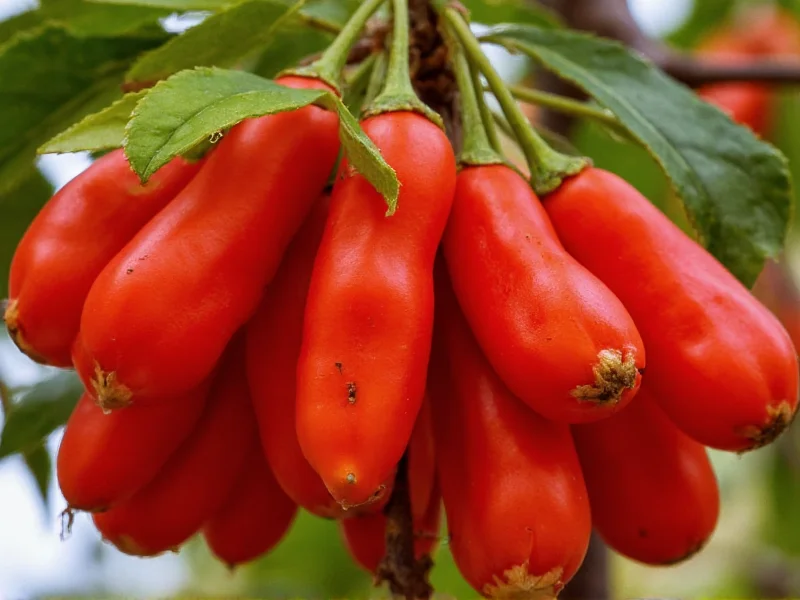When exploring the world of spicy fruit varieties, it's essential to understand botanical classifications versus culinary perceptions. While apples, oranges, and bananas never produce capsaicin—the chemical causing spicy heat—many plants we call vegetables in cooking are technically fruits. This distinction explains why chili peppers, despite being used as spices, are botanically classified as fruits.
The Botanical Truth About Spicy Fruits
Botanists define fruits as the seed-bearing structure that develops from a flower's ovary. By this definition, chili peppers qualify as fruits—and they're the only naturally occurring spicy fruit options containing significant capsaicin. The Scoville scale measures this heat, with varieties ranging from mild bell peppers (0 SHU) to Carolina Reapers (2.2 million SHU).
Other plants sometimes called "spicy fruits" don't contain capsaicin but create similar sensations through different compounds:
| Plant | Botanical Classification | Active Compound | Sensation Produced |
|---|---|---|---|
| Chili Peppers | True fruit (Capsicum spp.) | Capsaicin | Burning heat |
| Szechuan Peppercorns | Fruit (Zanthoxylum spp.) | Hydroxy-alpha-sanshool | Tingling/numbing |
| Miracle Fruit | True fruit (Synsepalum dulcificum) | Miraculin | Temporary taste modification |
| Grains of Paradise | Seed (Aframomum melegueta) | 6-paradol | Warm, peppery heat |
Why True Spicy Fruits Are Rare in Nature
Evolution explains why few fruits developed spiciness. Capsaicin evolved as a defense mechanism in chili peppers—deterring mammals (who would destroy seeds) while attracting birds (who disperse seeds intact). Most sweet fruits evolved to attract mammal consumers through sugar production, creating an evolutionary trade-off between spiciness and seed dispersal.
This biological reality means you won't find capsaicin in common fruits like mangoes or pineapples. However, culinary traditions worldwide combine these fruits with actual spicy elements:
- Mexican mango con chile: Ripe mango paired with chili powder and lime
- Thai som tam: Green papaya salad with bird's eye chilies
- Indian aamras: Mango pulp with black salt and chili
- Philippine sinigang: Tamarind-based soup with chili peppers
The Science Behind Spicy Fruit Sensations
Understanding how spicy fruit affects taste perception requires examining different receptor interactions:
Capsaicin activates TRPV1 receptors (heat/pain sensors), creating burning sensations. Hydroxy-alpha-sanshool in Szechuan pepper stimulates mechanoreceptors, causing tingling. Miraculin in miracle fruit binds to taste receptors, temporarily making sour foods taste sweet—a phenomenon sometimes confused with spiciness.
These distinct mechanisms explain why spicy fruit combinations work so effectively in global cuisines. The contrast between sweet fruit flesh and capsaicin's heat creates complex flavor profiles that enhance dining experiences while providing potential health benefits from capsaicin's anti-inflammatory properties.
Cultural Significance of Spicy Fruit Preparations
From street food to fine dining, spicy fruit pairings demonstrate remarkable cultural diversity:
In Mexico, chamoy—a sauce made from pickled fruits and chilies—appears on everything from fresh fruit to candies. Southeast Asian cultures frequently pair green mangoes with bird's eye chilies, while Indian cuisine uses raw mango with roasted chili powder in street snacks. These traditions highlight how humans creatively combine naturally sweet fruits with true spicy fruits (chilies) to create balanced flavor experiences.
When experimenting with spicy fruit recipes at home, start with mild chili varieties like jalapeños or serranos. Remember that capsaicin concentrates in seeds and membranes—removing these reduces heat significantly. Always wash hands after handling chilies, and consider dairy products (which contain casein) to counteract excessive heat.
Safety Considerations for Spicy Fruit Enthusiasts
While generally safe, some precautions apply when exploring spicy fruit options:
- Wear gloves when handling extremely hot peppers like habaneros
- Avoid touching eyes or face after handling chilies
- Start with small amounts to assess tolerance
- Keep dairy products nearby to neutralize capsaicin
- Be cautious with Szechuan pepper if you have mouth sensitivities
Understanding these fundamentals transforms your approach to spicy fruit exploration, helping you appreciate both the botanical realities and culinary possibilities. Whether you're seeking authentic global flavors or innovative cooking techniques, recognizing the distinction between true spicy fruits and spicy fruit combinations opens new dimensions in flavor exploration.











 浙公网安备
33010002000092号
浙公网安备
33010002000092号 浙B2-20120091-4
浙B2-20120091-4